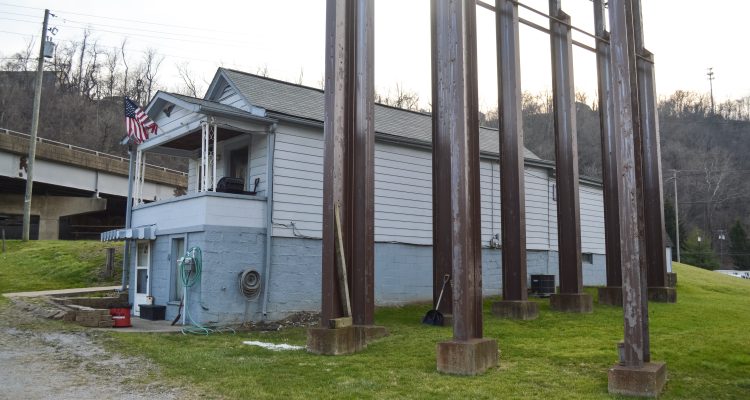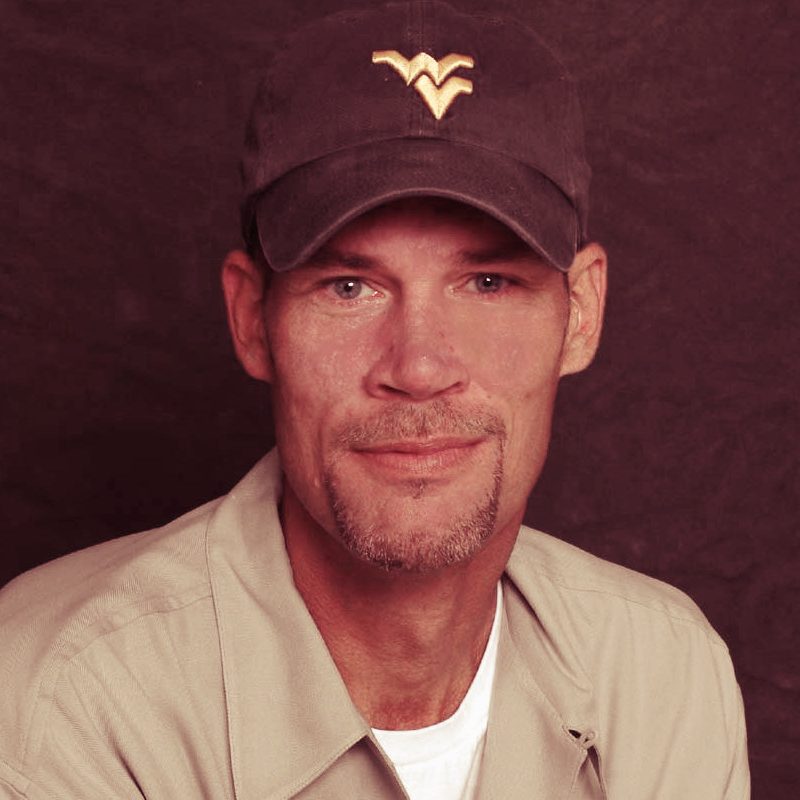There was that hum of about 65,000 cars and trucks zipping east and west every day, but Jim Hangler doesn’t hear that any longer.
This American veteran, a Purple Heart recipient for his duty in Vietnam, loves living in this slender structure that rests on Ellen Street only about 50 feet from the pillar supports for the bridge that leads motorists into and out of Wheeling Tunnel.
There are no next-door neighbors. Not anymore, anyway.
And yes, Hangler insists, it’s quiet.
And if he and his wife, Pam, turn left out of their driveway, they cruise to East Wheeling and to the downtown district, and if they turn right, they can travel to Fulton first, and then out the pike.
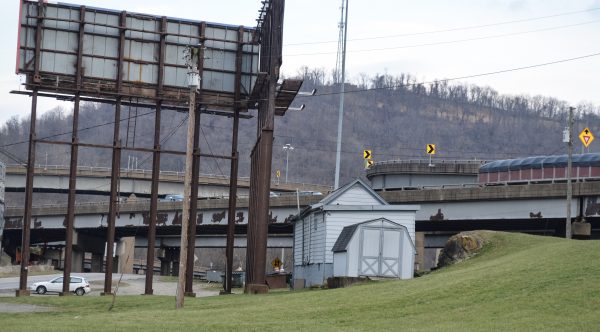
“I love it because it’s like living out of town, but we are still right in town,” Hangler said. “There’s some traffic, but there’s traffic almost everywhere you go, and like I said, I don’t even hear it anymore.”
His yard is large; he trims the grass around the tall, steel supports for two billboards that glare at travelers along Interstate 70, and the dwelling is mostly out of sight to those in the area because of the confusion created by the clover of roadways that guide motorists south to Moundsville, through the “Gateway to the West” toward Columbus, and in the direction of nearly 60 percent of the country’s population in the East.
But Hangler’s home for the last 17 years would likely no longer be where it’s settled if that clover’s ramps-to-nowhere actually went somewhere. The initial plan, according to DOH officials, was for W.Va. Route 2 through downtown Wheeling to be completely bypassed with the addition of access to those traveling the state highway.
That was “Phase 2,” and, well, it never transpired because of the barrier that is Wheeling Hill and the costs associated with going atop or through it.
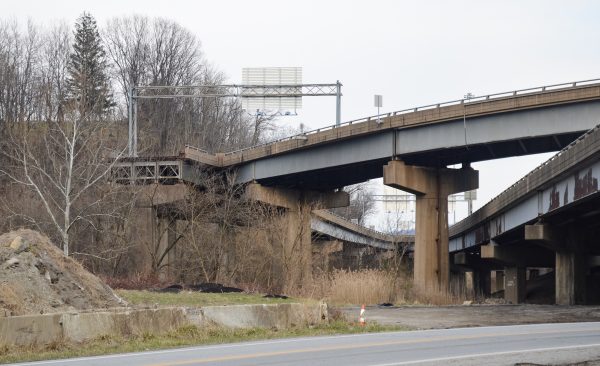
“One of those ramps was supposed to go to the north, from what I’ve heard, through a tunnel or something, and the other was supposed to go south. Well, you can go south, but if they would have built the ramps to the north, it would have taken this house,” he said. “But that never happened. Obviously, because we’re still here.”
The state’s Division of Highways initiated the W.Va. 2/U.S 250 bypass project soon after Interstate 70 opened to throughway traffic east and westbound, and that resulted in the demolition of more than 100 homes in the “Goosetown” section of East Wheeling. Mixed into the neighborhood were The Spot Bar and the Duquesne Club, but now all that remain are Baltimore Street and Lane J. Elizabeth Street, East 11th and East 12th streets, and everything constructed along those paths, were wiped away in the name of access.
“When I bought the house, I bought it off of Vinny Jacovetty from Ace Garage, and I asked him about what happened to all of the other houses that used to be around here because this neighborhood used to be a pretty popular place,” Hangler said. “Vinny told me that the state took most of the homes that were close to this one, but the guy who owned this place before Vinny bought it refused to sell. Vinny said that old guy told the state that he wasn’t going anywhere, and he kept fighting them.
“Only because that second phase never took place, this house stayed right where it is,” he said. “But I guess the state told that old man that he was going to have to leave when that second phase took place, but it never happened.”
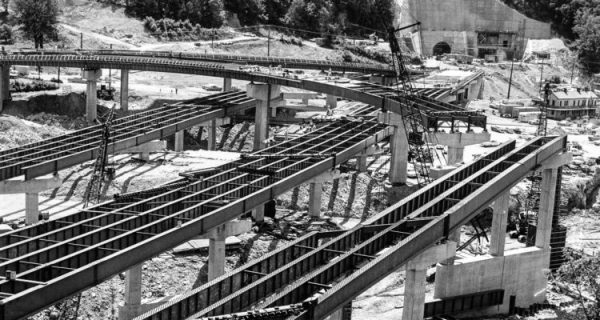
While Hanger and his bride have grown deaf to the buzz, there have been occasions when accidents have taken place on the roadways above. Several years ago, in fact, a local female lost her life during an incident that impacted both the eastbound and westbound lanes of I-70.
“That was a pretty scary situation, even for us all the way down here,” Hangler said with certainty. “It was a while ago, but I remember it pretty well because that poor girl was in an accident with one of those big trucks in the eastbound lanes, and she ended up in the westbound lanes and then was hit by another one of those trucks, from what the police said.
“We weren’t home at the time of the accident, but someone else who lives around here told me that there were police officers and state troopers walking all over our property,” he said. “When I asked why they were down here, my neighbor said they were looking for things that may have come over the edge in that accident. I didn’t ask for any more details other than that. I really didn’t want to know what they were looking for because that poor lady was ejected from her car, by what the news reported.”
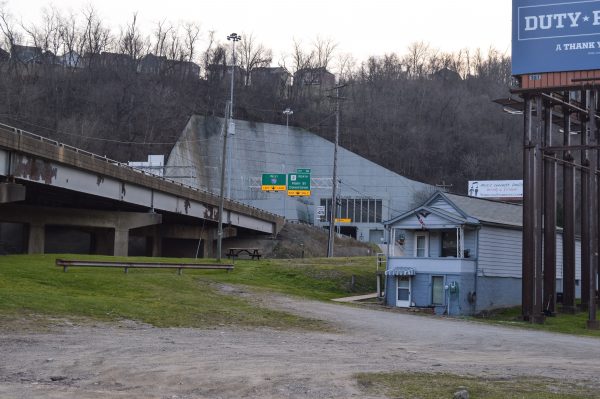
The span above the Hangler home is one of three bridge systems on the east side of Wheeling Tunnel, and the Division of Highways has announced its intention to finally fund a massive rehabilitation project to all three beginning next year, according to District Engineer Gus Suwaid. The public-private projects are projected at this time to cost $130 million with the state of West Virginia responsible for 10 percent.
The current plan calls for the first bridge to be completely rehabilitated, the second removed and re-constructed, and the third span, Suwaid has explained, will be re-decked and paved. The time it will take to perform the overdue infrastructure improvements is unknown at this time, but the federal roadways will be closed to traffic, and Interstate 470 will be utilized as the primary detour.
“I’m not worried about that project at all. I’ll probably just watch them do a lot of it,” Hangler said. “That’s what I do when they are performing the inspections. I sit there and watch those guys from my window; it’s cold outside. I find that stuff interesting.
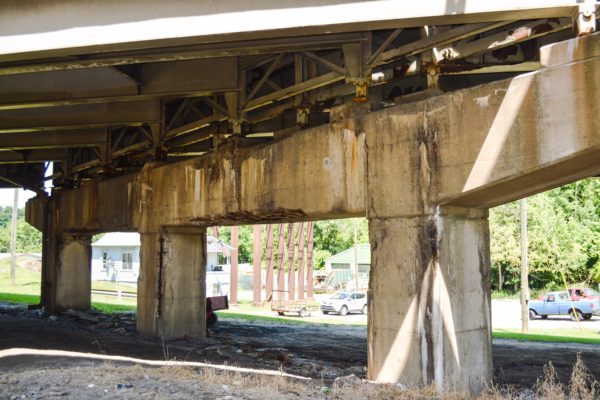
“I’m sure it will be a little noisy every once in a while, but everyone has to deal with a little noise sometimes, right? That’s why I’m not worried about it at all,” he said. “All kinds of people ask us about living here because they think that it must be a hassle or something, but I’m telling you it’s not a big deal at all. It’s actually a very convenient place to live because we can go either way from here and be in completely different sections of the city. It’s convenient like that.”
The Hanglers’ dwelling even featured an above-ground pool that was surrounded by a wood deck, but they opted to remove it a few years ago. “I just tired of taking care of it,” he said. “It was nice, but … .
“Listen, I know we almost live under that bridge, but we don’t mind it one bit. And hey, if it snows that bridge is like a carport, so that means I don’t ever have to scrape snow off the windshield,” Hangler said with a laugh. “It’s all about the little things, I guess.”
(Photos by Steve Novotney)


